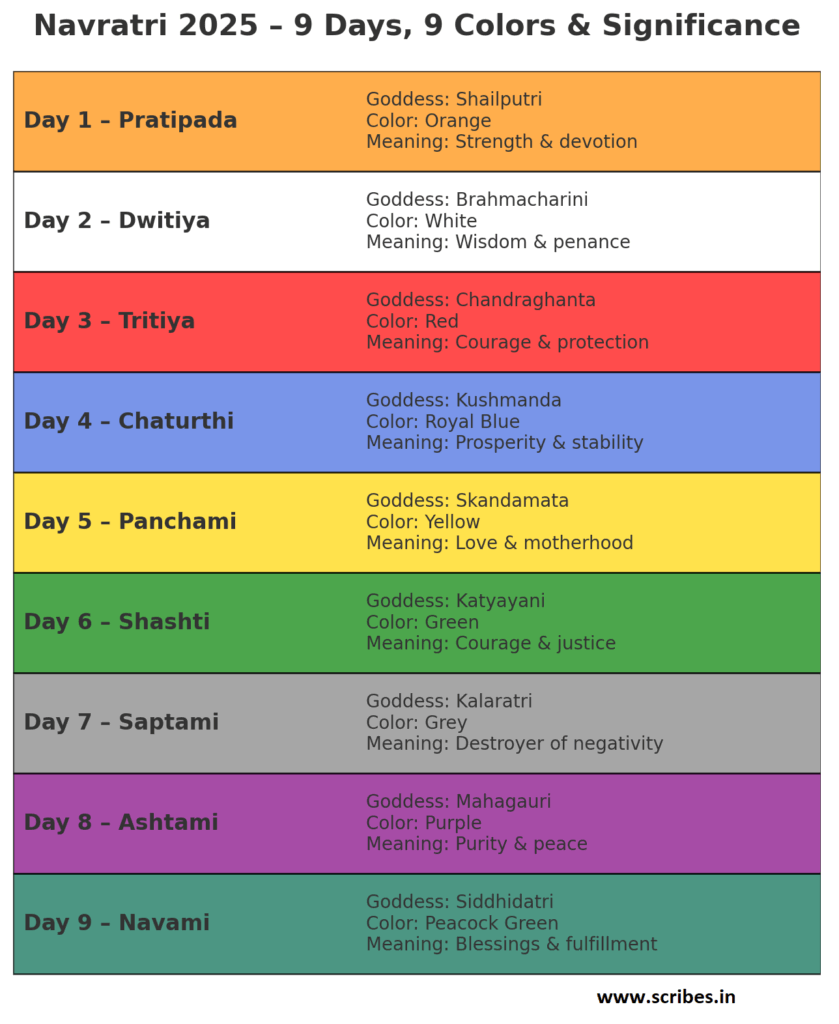Navratri, which will be celebrated from 22nd September to 2nd October 2025 in India, is one of the most celebrated Hindu festivals, a nine-day spiritual journey dedicated to Goddess Durga and her nine divine forms. Each day of Navratri is associated with a specific color, which carries deep symbolism and is believed to bring positivity and blessings when worn. Devotees across India and abroad follow this tradition, dressing in the designated color for each day while offering prayers, fasting, and performing rituals.
But Navratri is not just about colors and fasting — it also leads into Durga Puja, one of the grandest festivals of India especially in North India and West Bengal. While Navratri celebrates the nine divine forms of Goddess Durga, Durga Puja marks the victory of Goddess Durga over the demon king Mahishasura, symbolizing the triumph of good over evil. In North India, especially in states like Uttar Pradesh, Bihar, Delhi, and Haryana, Navratri and Durga Puja are celebrated with grandeur through devotional songs, Ramleela performances, and festive gatherings.
The 9 Days of Navratri, Their Colors, and Significance
Day 1 – Pratipada (Goddess Shailputri) – Orange
- Significance of the day: Goddess Shailputri, the daughter of the Himalayas, represents strength and devotion.
- Why Orange? The vibrant color symbolizes energy, enthusiasm, and a new beginning. Wearing orange sets a positive tone for the festival.
Day 2 – Dwitiya (Goddess Brahmacharini) – White
- Significance of the day: Brahmacharini embodies wisdom, penance, and spiritual growth.
- Why White? This pure color represents peace, purity, and serenity, inspiring devotees to embrace simplicity and devotion.
Day 3 – Tritiya (Goddess Chandraghanta) – Red
- Significance of the day: Chandraghanta is the goddess of bravery and courage who protects devotees from evil.
- Why Red? The color symbolizes power, passion, and strength. It inspires confidence and determination.
Day 4 – Chaturthi (Goddess Kushmanda) – Royal Blue
- Significance of the day: Goddess Kushmanda is believed to have created the universe with her smile and radiates warmth.
- Why Royal Blue? This deep shade stands for prosperity, richness, and calmness. It helps devotees focus on inner stability.
Day 5 – Panchami (Goddess Skandamata) – Yellow
- Significance of the day: Skandamata, the mother of Lord Kartikeya, represents love, kindness, and motherhood.
- Why Yellow? A color of happiness and optimism, yellow brings joy and positivity, reflecting the nurturing energy of the Goddess.

Day 6 – Shashti (Goddess Katyayani) – Green
- Significance of the day: Katyayani is a fierce form of Durga, a symbol of courage and justice.
- Why Green? Green represents growth, new beginnings, and harmony. It inspires balance and determination.
Day 7 – Saptami (Goddess Kalaratri) – Grey
- Significance of the day: Kalaratri is the fiercest form of Goddess Durga, destroying negativity and evil.
- Why Grey? This balanced shade reflects the power of transformation and the courage to overcome challenges.
Day 8 – Ashtami (Goddess Mahagauri) – Purple
- Significance of the day: Mahagauri signifies purity, inner peace, and wisdom.
- Why Purple? A royal and spiritual color, purple represents dignity, devotion, and deep spiritual knowledge.
Day 9 – Navami (Goddess Siddhidatri) – Peacock Green
- Significance of the day: Siddhidatri blesses her devotees with spiritual and worldly powers, fulfilling their wishes.
- Why Peacock Green? A mix of beauty and serenity, this shade stands for compassion, kindness, and prosperity.
Navratri and Durga Puja – A Unified Celebration of Shakti
The tradition of 9 colors of Navratri is not just about wearing different outfits each day; it is a spiritual practice that aligns devotees with the divine energies of Goddess Durga. Each color holds a special vibration, reminding us of values like courage, purity, wisdom, and devotion.
As the nine days of Navratri conclude, the celebrations transition into Durga Puja, especially in North India, where large pandals, devotional music, and Ramleela mark the festive spirit. Both Navratri and Durga Puja celebrate the victory of good over evil, uniting millions of devotees in faith, devotion, and cultural vibrancy.
By embracing the colors, rituals, and essence of Navratri, devotees invite positivity, strength, and blessings into their lives during this auspicious festival.

